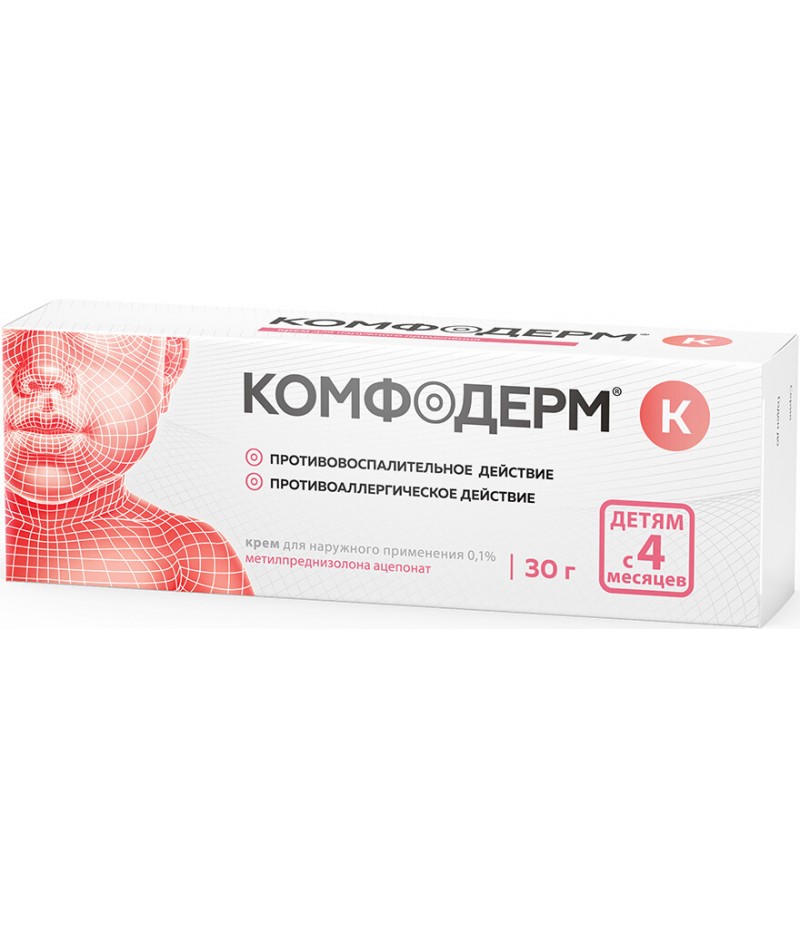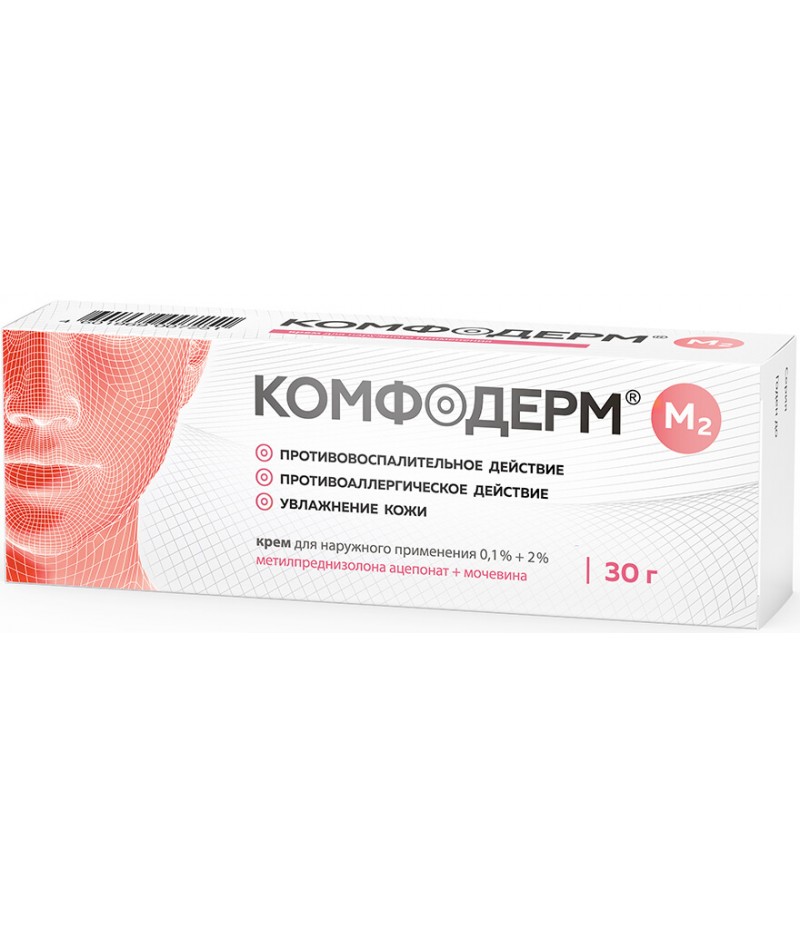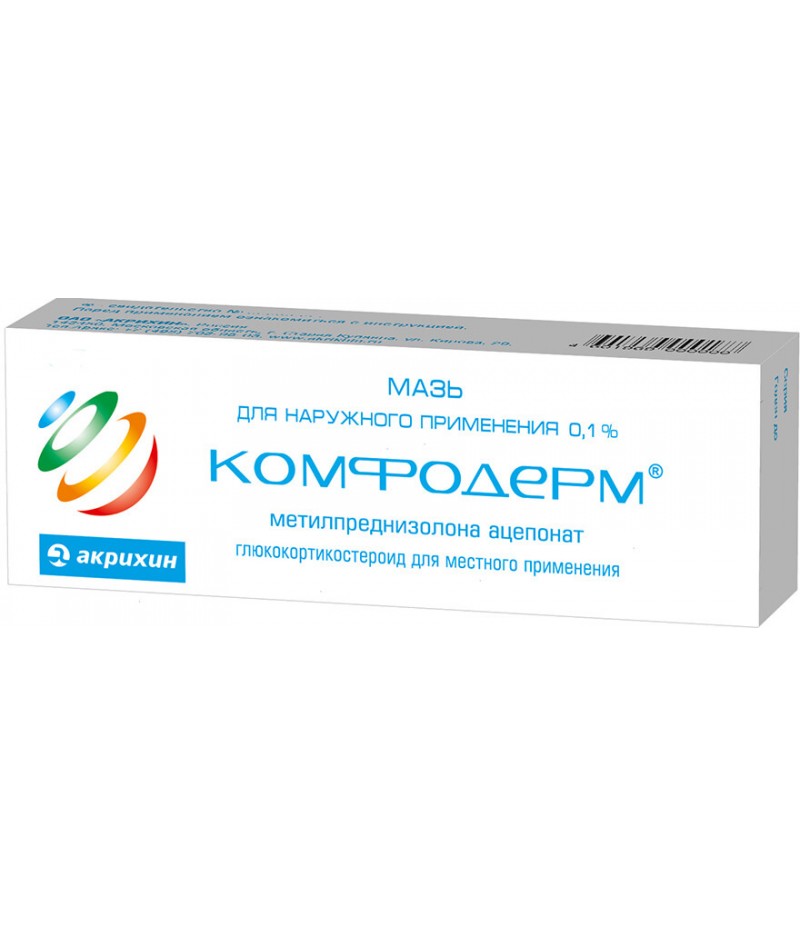Comfoderm K cream 0.1% 30gr
- $30.19
- 3 or more $29.99
- Availability:In Stock
Instruction for Comfoderm KYou can buy Comfoderm K hereCream for external use 0.1% white or almost white, with a weak specific odor.Composition100 gmethylprednisolone aceponate (in terms of 100% substance) \ 00090.1 gExcipientscer..
Tags: cream
Instruction for Comfoderm K
You can buy Comfoderm K here
Cream for external use 0.1% white or almost white, with a weak specific odor.
Composition
100 g
methylprednisolone aceponate (in terms of 100% substance) \ 00090.1 g
Excipients
ceramides - 0.5 g, Euxyl PE 9010 preservative (phenoxyethanol - 90%, ethylhexylglycerol - 10%) in terms of phenoxyethanol - 0.9 mg, isopropyl myristate - 7 g, octyldodecanol - 7 g, hexyl decyl stearate - 7 g, dimethicone, 100 cst - 7 g, dimethicone, 100 cst - 7 g, hexyl decyl stearate - 7 g, dimethicone, 100 cst - 7 g, dimethicone, 100 cst propylene glycol - 7 g, macrogol 40 stearate - 1.5 g, glyceryl monostearate - 8.5 g, cetostearyl alcohol (cetyl alcohol - 60%, stearyl alcohol - 40%) - 2 g, disodium edetate - 0.1 g, potassium dihydrogen phosphate - 0.49 g, sodium hydrophosphate dodecahydrate - 0.01 g, purified water - up to 100 g.
pharmachologic effect
GKS for external use. Suppresses the function of leukocytes and tissue macrophages. Limits the migration of leukocytes to the area of inflammation. Violates the ability of macrophages to phagocytosis, as well as to the formation of interleukin-1. Promotes the stabilization of lysosomal membranes, thereby reducing the concentration of proteolytic enzymes in the area of inflammation. Reduces the permeability of capillaries due to the release of histamine. Suppresses the activity of fibroblasts and the formation of collagen.
Inhibits the activity of phospholipase A2, which leads to suppression of the synthesis of prostaglandins and leukotrienes. Suppresses the release of COX (mainly COX-2), which also contributes to a decrease in the production of prostaglandins.
Reduces the number of circulating lymphocytes (T-and B-cells), monocytes, eosinophils and basophils due to their movement from the vascular bed to the lymphoid tissue; inhibits the formation of antibodies.
Methylprednisolone aceponate suppresses the release of ACTH and--lipotropin by the pituitary gland, but does not reduce the level of circulating энд-endorphin. It inhibits the secretion of TSH and FSH.
When applied directly to the vessels, it causes a vasoconstrictor effect.
When applied topically and locally, the therapeutic activity of methylprednisolone is due to the anti-inflammatory, antiallergic and anti-exudative (due to the vasoconstrictor effect) action.
Pharmacokinetics
Methylprednisolone aceponate is hydrolyzed in the epidermis and dermis. The main and most active metabolite is 6 alpha-methyl predisolone-17-propionate, which has a significantly higher affinity for the glucocorticosteroid receptors of the skin, which indicates the presence of its “bioactivation” in the skin.
The degree of percutaneous absorption depends on the condition of the skin, the dosage form and the method of application (with or without an occlusive dressing).
After entering the systemic bloodstream 6, alpha-methylprednisolone-17-propionate quickly contacts with glucuronic acid and, thus, in the form of 6 alpha-methylprednisolone-17-propionate, glucuronide is inactivated.
Metabolites of methylprednisolone aceponate are eliminated mainly by the kidneys with a half-life of about 16 hours. Methylprednisolone aceponate and its metabolites are not cumulative in the body.
Side effects of cream Comfoderm K
The incidence of side effects is classified according to the recommendations of the World Health Organization (WHO): very often (> 10%), often (> 1%,
<1%), infrequently (> 0.1%, <1%), rarely (> 0.01%, <0.1%), very rarely (<0.01%). the frequency is unknown (it is possible to estimate the frequency of ns occurrence).
Violations of the skin and subcutaneous tissues: rarely - perioral dermatitis, skin depigmentation, allergic reactions to the components of Comfoderm K; frequency is unknown - skin atrofofia, telangiectasia, striae, acne-like skin changes (when using Comfoderm K for more than 4 weeks and / or on an area of 10% or more of the body surface).
General disorders and disorders at the injection site: rarely - folliculitis, hypertrichosis; it is rarely - itching, burning, erythema, the formation of vesicular rash; the frequency of the unknown systemic effects1> 1, due to the absorption of a glucocorticosteroid (when using the npei arata for more than 4 weeks and / or on an area of 10% or more of the body surface).
If any of the side effects indicated in the instructions are aggravated, or any other side effects that are not indicated in the instructions are noted, you should immediately inform your doctor.
Indications for Comfoderm K
Inflammatory skin diseases sensitive to therapy with topical glucocorticosteroids:
atopic dermatitis, neurodermatitis, children eczema;
true eczema;
microbial eczema
professional eczema;
simple contact dermatitis;
allergic (contact) dermatitis;
dyshidrotic eczema.
Contraindications of Comfoderm K
tuberculous or syphilitic processes in the field of drug application; viral diseases (for example, chicken pox, shingles) in the area of application of Comfoderm K;
rosacea, perioral dermatitis in the area of application of Comfoderm K; children's age up to 4 months;
skin areas with reactions to vaccination; hypersensitivity to Comfoderm K.
Use during pregnancy and during breastfeeding
If you need to use the drug Comfoderm K during pregnancy and during breastfeeding, you should carefully weigh the potential risk to the fetus and the expected benefit of treatment for the mother. During these periods, prolonged use of the drug on the extensive surfaces of the skin is not recommended; nursing mothers should not apply Comfoderm K to the mammary glands.
Dosage
Apply externally 1 time / day with a thin layer on the affected area, slightly rubbing. Use with an occlusive dressing is possible. Typically, the treatment is for adults no more than 12 weeks, and for children - no more than 4 weeks. During the year it is possible to conduct several courses of therapy.
Terms of sell
You can buy Comfoderm K without a prescription.



